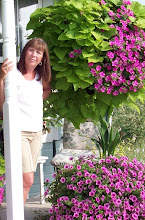 Two years ago, right around the end of summer, I happened upon an interesting plant at a local nursery and although I didn't know much about it, I decided to give it a try. I bought two single stemmed plants---one for either side of the flower beds in my courtyard. For the rest of the summer and into fall, those two plants were completely unimpressive. They didn't change in size and before the first frost every took them, they'd died off. So much for the gooseneck loosestrife, I thought.
Two years ago, right around the end of summer, I happened upon an interesting plant at a local nursery and although I didn't know much about it, I decided to give it a try. I bought two single stemmed plants---one for either side of the flower beds in my courtyard. For the rest of the summer and into fall, those two plants were completely unimpressive. They didn't change in size and before the first frost every took them, they'd died off. So much for the gooseneck loosestrife, I thought.Guess again.
Last spring, I went out to the courtyard and there were all these tiny green plants pushing up through the mulch around the area where the loosestrife had (supposedly) died. In fact, they were completely surrounding my Ming Toy daylily and my yellow shrub rose. Lucky for me, daylilies and shrub roses can stand their ground. Fortunately, I hadn't planted heavily in that area and the loosestrife had room to spread out without bothe
 ring less vigorous perennials. Unfortunately, the loosestrife would keep taking purchase throughout the bed and eventually kill off less vigorous perennials.
ring less vigorous perennials. Unfortunately, the loosestrife would keep taking purchase throughout the bed and eventually kill off less vigorous perennials.So what to do?
I really debated over the problem because 1) this was the first time I'd encountered a problem with an invasive, 2) I liked the look of it in the flower bed, and 3) it's heat and drought tolerance made it an ideal candidate for that particular area. I chose to wait and deal with it this coming spring.
Why? Because I find its always easier to deal with a problem area first thing in the spring before a plant has a chance to completely develop. My first preemptive strike is to establish a perimeter for the gooseneck. One can discourage rampant roots by sinking metal or plastic edging as a barrier around the offending plants. I have some left over pound-in edging from another project that should work nicely. Any gooseneck loosestrife outside the established barrier will then be dug up or sprayed with herbicide. Lastly, immediately after flowering, deadheading is a must to prevent self-sowing. Hopefully I'll be able to manage the loosestrife without having to completely eradicate it. I'll let you know how it works.
Gardening Tip: Spraying herbicide in a bed that contains the invasive culprit but is also home to desirable perennials can be tricky. I use a 2 liter soda bottle or a milk jug to prevent overspray. Cut away 2 inches of the bottom of the bottle or jug so that it can be placed over the undesirable plant and spray the herbicide through the cap end. The herbicide goes directly to the undesirable plant without fear of the spray getting on any nearby neighbors.
Invasive plant list: There are many sites on the web where one can gather information on invasive plants. For a list of plants specifically for a certain area or state, contact your local county extension office. It's good to know before you plant. Below are just a scant few of the many plants to look out for:
trumpet creeper
purple loosestrife
lamb's ear
goldenrod
honeysuckle
Japanese knotweed
mint





